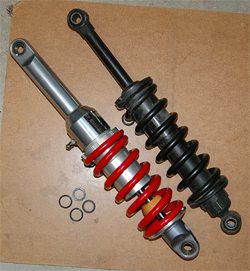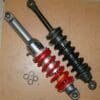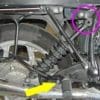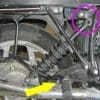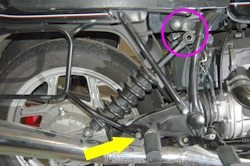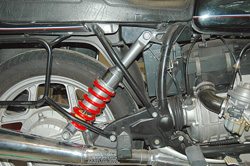Summary
Very nicely made shock absorber; looks like custom made.
Chromoly steel; rebuildable. Nitrogen gas charged. Comes with cool-looking progressive rate springs in black or red.
Internal bladder eliminates need for external reservoir. Five position damping adjustment.
Threaded collar adjusts preload but collar is a bit stiff and doesn’t turn easily. Provides excellent ride characteristics and gives very smooth but controlled ride. Gives the bike’s rear end a “silky buttery” feel without wallowing.
Introduction
Motorcycle suspension parts take a beating, and motorcycle shock absorbers and springs don’t seem to last long at all. Automobiles can sometimes go 70k miles or so before the shocks need replacing, but a 600-pound motorcycle’s suspension can be gone in as little as 12,000 miles.
Our 1986 BMW R65 test mule came to us with a ’70’s style BMW suspension: soft and cushy. According to Roland Slabon’s book “BMW Motorcycle Buyer’s Guide” (review), only 364 of these rare monoshock BMW’s were imported into the U.S.A. in 1986.
It was comfortable to ride in an old-fashioned sort of way, and it handled well enough for the vintage, so it didn’t occur to anyone that the rear shock was knackered. Until the handling got very weird…
The bike felt like it was on ball bearings – as soon as the handlebars were moved in any direction, the rear end of the bike felt like it would swing out as if on a hinge. This was way more play than the “normal” BMW Airhead frame flex should allow, and it got too scary to ride.
At first, we thought something was wrong with the steering head bearing adjustment. Many attempts at changing this didn’t do a thing for the handling problem though. A quick note to the BMW Airheads email list came back with recommendations to check the frame for cracking. But the bike only has about 25k miles on it, and the frame and engine mounting bolts seemed fine.
A visitor to the wBW garage, after hearing the story, walked up to the back of the bike and pushed up and down. The suspension had about as much stiffness as a wet noodle. It became immediately obvious that the monoshock, a Koni (probably a replacement for the OEM BMW part) was completely gone. The spring was the only thing holding up the rear.
Why hadn’t we noticed this? Like old age, motorcycle suspension failure starts the day the bike is built and is a subtle but continuous process. You get used to the way the bike rides and subconsciously compensate for it, until one day there’s a sudden realization that something is seriously wrong.
Well, Koni is long since out of the business of manufacturing shock absorbers for motorcycles. Apparently, they sold the tooling to a manufacturer who makes the shocks under the “Ikon” (Koni spelled backwards!) name. Hagon also makes a replacement monoshock, but many owners of BMWs and other brands of bikes recommended Progressive Suspension’s products
Progressive Suspension
Progressive Suspension has been around virtually forever, and they make shocks and springs for many different brands of street and off-road motorcycles; vintage and classic motorcycles; cruisers and even bicycles and radio controlled cars. Their piggyback reservoir shocks for R/C cars are a sight to behold!
Their products are commonly available at many motorcycle dealers and online retailers, and one of the nice things about the Progressive 420 is that it’s rebuildable, making it virtually a lifetime shock. The prices are reasonable also, relatively speaking, that is. Motorcycle shocks are not cheap, and high-end racing shocks can cost several thousand dollars.
We found this 420 with bright red springs on sale, and purchased both the shock and a set of Progressive Suspension fork springs for a grand total of $444.00, including shipping. We haven’t been able to figure out how to disassemble the forks on the R65 just yet, so that story will have to wait.
Progressive 420 Monoshock
The Progressive 420 is a real beauty. The body of the shock is made from 14 mm chromoly steel, and it’s hard chrome plated. It looks like it’s custom-made; as an ex-machinist, I can appreciate from the way the shock is made. The taper up from the main body of the shock, and the upper and lower ball joint are especially nice looking.
Only the 420 with red springs was available when this was purchased, but that was fine with me. The red complements the red pinstripe on the jet black R65’s tank and battery covers, and gives the bike a custom look. There was a very small ding on the red finish on one of the windings of the spring, so we’ll see how the finish holds up. It appears to be some type of plastic-like coating and not a paint or powder coat.
|
|
|
|
I wasn’t sure how hard or easy it would be to install the shock on the R65. This bike has a set of BMW saddlebag mounts installed, and the frame rails for the mounts covered the existing shock. It’s a pain to remove the mounts, but as it turned out, that wasn’t necessary.
I found that it was only necessary to remove a single bolt (yellow arrow, photo left) from the lower saddlebag mounting rail, which provide enough play for the old shock to be removed and to install the new one.
The monoshock attaches to the bike with upper and lower mounting bolts. After removing the two nuts that held the old shock in place, it was possible to twist to top of the shock enough to slide it off the mount.
Sliding the shock off its lower mounting stud was slightly harder, but after some twisting and maneuvering, it came off without having to remove any other parts.
By the way, make sure the rear of the bike is propped up under the tire, because there’s nothing holding up the rear of the bike once the monoshock is removed. As always, use caution.
This Progressive 420 came with 4 washers. One washer goes on each side of the upper and lower mounts, and they help to ensure that the mounts don’t bind on the bike’s frame as the suspension travels up and down.
Installing the Progressive 420
I didn’t want to mar the beautiful surface of the new Progressive shock, so I was very careful when installing it. The round ball joint type ends in the upper and lower shock mounts are easy to rotate, and this helped to make the installation go smoothly. Once the shock is in place, torque the nuts to specifications and don’t forget to tighten the saddlebag bolt if you have one.
The damping was at the third setting from the factory, and that’s where I left it. I toyed with the preload a little bit, but no particular setting seems to make much of a difference, probably because the bike’s suspension is rather crude anyway and the small adjustments on the shock don’t make it through all the rest of the chassis flex to make themselves noticed.
The shock comes with a preload adjustment wrench that works with a 3/8″ drive ratchet. The spring has a lot of compression against the preload adjustment collar, making the collar difficult to turn. I’m also afraid that turning the ring will wear away the red coating on the spring’s coils. I’m hoping that once the nice red coating starts coming off that it won’t begin to peel away from all of the entire spring. Only time will tell…
But the bottom line is that the Progressive 420 is a revelation. The bike now handles better than it ever did, and it’s a nice feeling to think that a nearly twenty year old bike handles better than some new ones I’ve ridden. It’s hard to describe, but the shock really smoothes out all the bumps with a very silky feel.
There’s no abruptness or harshness at all, and the best thing I can say about it is that I don’t notice what’s happening in the rear of the bike at all, other than it goes where I want it to with no fuss.
And the rear end doesn’t wallow at all (like it did with the old shock), so it’s a very controlled but smooth feeling, both on compression and rebound. If we would have known that this was possible, we would have replaced the shock a long time ago with a Progressive unit, even before the original unit was worn.
I also wanted to perk up the R65’s front end; see the wBW article on installing a set of Progressive fork springs for more information.
Meantime, the 420 has made a huge difference in the way the R65 handles and feels, so I’m very pleased. Progressive makes an extensive line of shocks and springs for many different motorcycle brands and models, so chances are they’ll have one for your bike.
|
wBW Product Review: Progressive Suspension 420-Series Shock Absorber |
|
| Available From: Progressive Suspension Made in: U.S.A. |
Suggested Retail Price: $418.70 (Street price is ~$380.00) |
| Review Date: August 2004 | |
| More wBW : Motorcycle Maintenance and Repair | Motorcycle Performance Parts | |
Note: For informational use only. All material and photographs are Copyright © webWorld International, LLC – 2000-2011. All rights reserved. See the webBikeWorld® Site Info page. NOTE: Product specifications, features and details may change or differ from our descriptions. Always check before purchasing. Read the Terms and Conditions!
Owner Comments and Feedback
Not all comments will be published (details). Comments may be edited for clarity prior to publication.
From “S.B.” (09/10): “I recently read your article about installing a Progressive Monoshock on your 1986 Airhead.
I have a 1987 R80RT monoshock that came to me with a Fox Shox Twin Clicker. This racing shock blew seals twice a year and I was tired of having it rebuilt. I’ve had Progressive shocks and springs on two Yamahas and my boxer has their springs in the front end. So I bought a 420 series monoshock from them and put it on my Airhead.
It is a significantly better ride in every way. It’s certain to out-perform my seal blowing Twin Clicker. Mine came with black spring, rather than the red spring on yours.”


